Dynamic and Multidimensional Risk Assessment Methodology for Coal Mine Fire Prevention: An INK-FBSD Approach
Abstract
1. Introduction
2. Materials and Methods
3. Results
3.1. ISM-Based Coal Mine Fire Risk Factor Discrimination and Hierarchy Research
3.2. Coupled Analysis of Coal Mine Fire Risk Factors Based on the N-K Model
3.3. Steps in Analyzing Fuzzy Bayesian Network Models
3.4. System Dynamics Simulation
4. Discussion
5. Conclusions
Author Contributions
Funding
Institutional Review Board Statement
Informed Consent Statement
Data Availability Statement
Conflicts of Interest
References
- Chu, C.; Muradian, N. Safety and Environmental Implications of Coal Mining. Int. J. Environ. Pollut. 2016, 59, 250–268. [Google Scholar] [CrossRef]
- Zhu, Y.; Wang, D.; Shao, Z.; Xu, C.; Zhu, X.; Qi, X.; Liu, F. A Statistical Analysis of Coal Mine Fires and Explosions in China. Process Saf. Environ. Prot. 2019, 121, 357–366. [Google Scholar] [CrossRef]
- Tong, R.; Yang, Y.; Ma, X.; Zhang, Y.; Li, S.; Yang, H. Risk Assessment of Miners’ Unsafe Behaviors: A Case Study of Gas Explosion Accidents in Coal Mine, China. Int. J. Environ. Res. Public Health 2019, 16, 1765. [Google Scholar] [CrossRef]
- Li, S.; You, M.; Li, D.; Liu, J. Identifying Coal Mine Safety Production Risk Factors by Employing Text Mining and Bayesian Network Techniques. Process Saf. Environ. Prot. 2022, 162, 1067–1081. [Google Scholar] [CrossRef]
- Dey, P.; Chaulya, S.; Kumar, S. Hybrid CNN–LSTM and IoT-Based Coal Mine Hazards Monitoring and Prediction System. Process Saf. Environ. Prot. 2021, 152, 249–263. [Google Scholar] [CrossRef]
- Jafari, M.J.; Pouyakian, M.; Hanifi, S.M. Reliability Evaluation of Fire Alarm Systems Using Dynamic Bayesian Networks and Fuzzy Fault Tree Analysis. J. Loss Prev. Process Ind. 2020, 67, 104229. [Google Scholar] [CrossRef]
- Yazdi, M.; Kabir, S. A Fuzzy Bayesian Network Approach for Risk Analysis in Process Industries. Process Saf. Environ. Prot. 2017, 111, 507–519. [Google Scholar] [CrossRef]
- D’Angelo, M.F.; Palhares, R.M.; Cosme, L.B.; Aguiar, L.A.; Fonseca, F.S.; Caminhas, W.M. Fault Detection in Dynamic Systems by a Fuzzy/Bayesian Network Formulation. Appl. Soft Comput. 2014, 21, 647–653. [Google Scholar] [CrossRef]
- Kumari, K.; Dey, P.; Kumar, C.; Pandit, D.; Mishra, S.; Kisku, V.; Chaulya, S.; Ray, S.; Prasad, G. UMAP and LSTM Based Fire Status and Explosibility Prediction for Sealed-Off Area in Underground Coal Mine. Process Saf. Environ. Prot. 2020, 146, 837–852. [Google Scholar] [CrossRef]
- Tripathi, A.; Khan, M.M.; Pain, A.; Rai, N.; Iqbal, M.A. Compressive Strength of Thermally Treated Barakar Sandstone in Jharia Coal Mine Fire Region: Interplay of Strength, Strain Rate, and Temperature. Eng. Fract. Mech. 2025, 319, 111002. [Google Scholar] [CrossRef]
- Ganco, M. NK Model as a Representation of Innovative Search. Res. Policy 2017, 46, 1783–1800. [Google Scholar] [CrossRef]
- Wu, C.; Zhou, L.; Jin, J.; Ning, S.; Zhang, Z.; Bai, L. Regional Water Resource Carrying Capacity Evaluation Based on Multidimensional Precondition Cloud and Risk Matrix Coupling Model. Sci. Total Environ. 2019, 710, 136324. [Google Scholar] [CrossRef]
- Tahir, M.; Aslam, M.; Hussain, Z.; Khan, A.A. On the 3-Component Mixture of Exponential, Rayleigh and Burr Type-XII Distributions: A Simulation Study in Bayesian Framework. Chiang Mai J. Sci. 2018, 45, 1161–1180. [Google Scholar]
- Tako, A.A.; Robinson, S. The Application of Discrete Event Simulation and System Dynamics in the Logistics and Supply Chain Context. Decis. Support Syst. 2011, 52, 802–815. [Google Scholar] [CrossRef]
- Watson, R.H. Interpretive Structural Modeling—A Useful Tool for Technology Assessment. Technol. Forecast. Soc. Change 1978, 11, 165–185. [Google Scholar] [CrossRef]
- Zhang, X.W.; Xie, W.J. The Application of ISM Model in Risk Structure Analysis. Commer. Res. 2002, 2, 3. [Google Scholar] [CrossRef]
- Wu, B.-J.; Jin, L.-H.; Zheng, X.-Z.; Chen, S. Coupling Analysis of Crane Accident Risks Based on Bayesian Network and the NK Model. Sci. Rep. 2024, 14, 1133. [Google Scholar] [CrossRef]
- Li, M.; Wang, H.; Wang, D.; Shao, Z.; He, S. Risk Assessment of Gas Explosion in Coal Mines Based on Fuzzy AHP and Bayesian Network. Process Saf. Environ. Prot. 2020, 135, 207–218. [Google Scholar] [CrossRef]
- Randers, J. Elements of the System Dynamics Method. J. Oper. Res. Soc. 1997, 48, 1144–1145. [Google Scholar] [CrossRef]
- GB/T 50448-2015; Technical Code for Application of Cementitious Grout. China Architecture & Building Press: Beijing, China, 2015.
- MT/T 850-2000; Specification for Grouting Materials for Coal Mine Engineering. China Coal Industry Publishing House: Beijing, China, 2000.
- Kenett, R.S. Bayesian Networks: Theory, Applications and Sensitivity Issues. Encycl. Semant. Comput. Robot. Intell. 2017, 1, 1630014. [Google Scholar] [CrossRef]
- Qiao, W. Analysis and Measurement of Multifactor Risk in Underground Coal Mine Accidents Based on Coupling Theory. Reliab. Eng. Syst. Saf. 2021, 208, 107433. [Google Scholar] [CrossRef]
- Zhang, J.; Fu, J.; Hao, H.; Fu, G.; Nie, F.; Zhang, W. Root Causes of Coal Mine Accidents: Characteristics of Safety Culture Deficiencies Based on Accident Statistics. Process Saf. Environ. Prot. 2020, 136, 78–91. [Google Scholar] [CrossRef]
- Wang, J.; Ding, D.; Liu, O.; Li, M. A Synthetic Method for Knowledge Management Performance Evaluation Based on Triangular Fuzzy Number and Group Support Systems. Appl. Soft Comput. 2015, 39, 11–20. [Google Scholar] [CrossRef]
- Li, Q.; Zhang, L.; Zhang, L.; Jha, S. Exploring Multi-Level Motivations Towards Green Design Practices: A System Dynamics Approach. Sustain. Cities Soc. 2021, 64, 102490. [Google Scholar] [CrossRef]
- Groesser, S.N.; Schaffernicht, M. Mental Models of Dynamic Systems: Taking Stock and Looking Ahead. Syst. Dyn. Rev. 2012, 28, 46–68. [Google Scholar] [CrossRef]
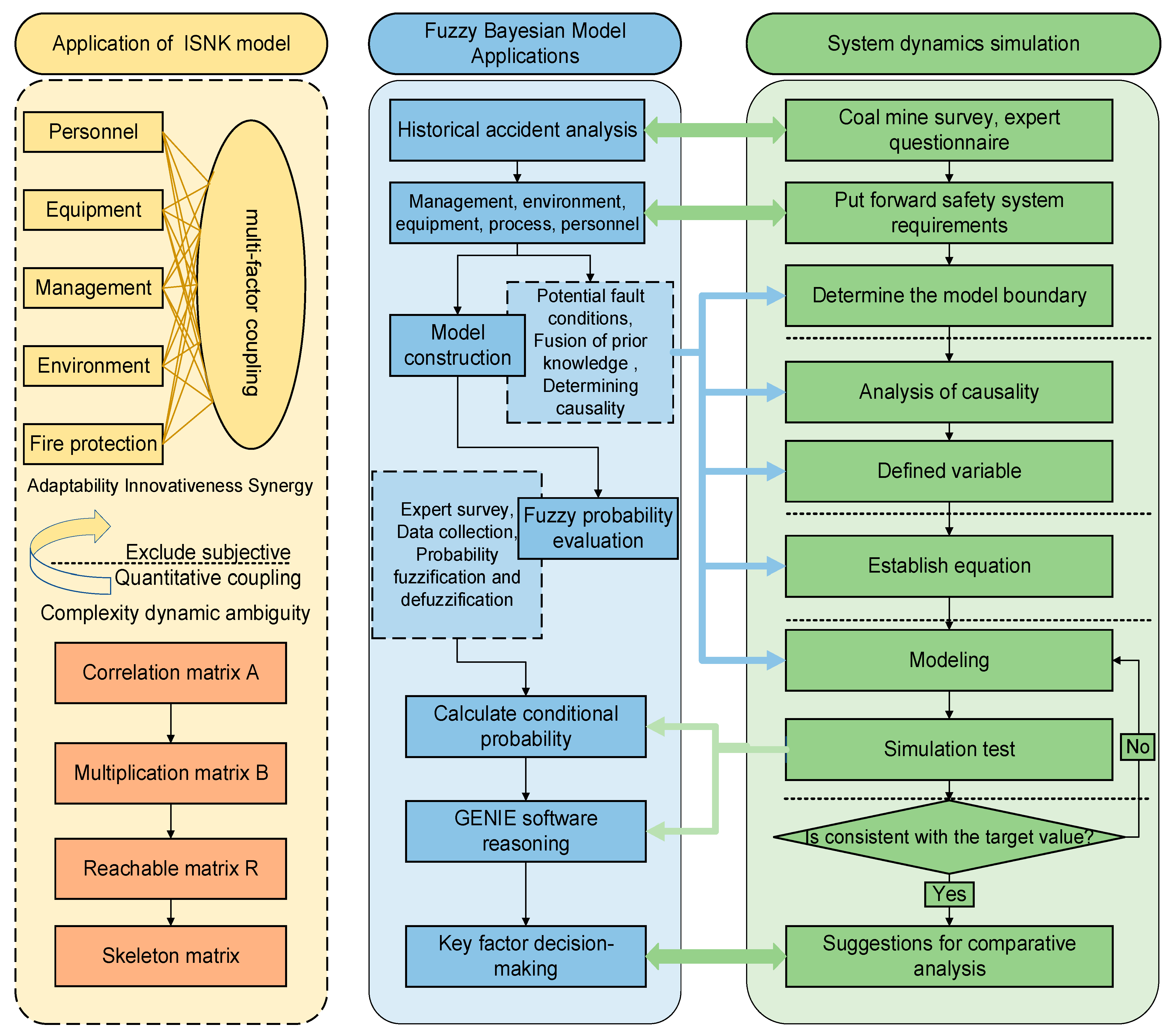
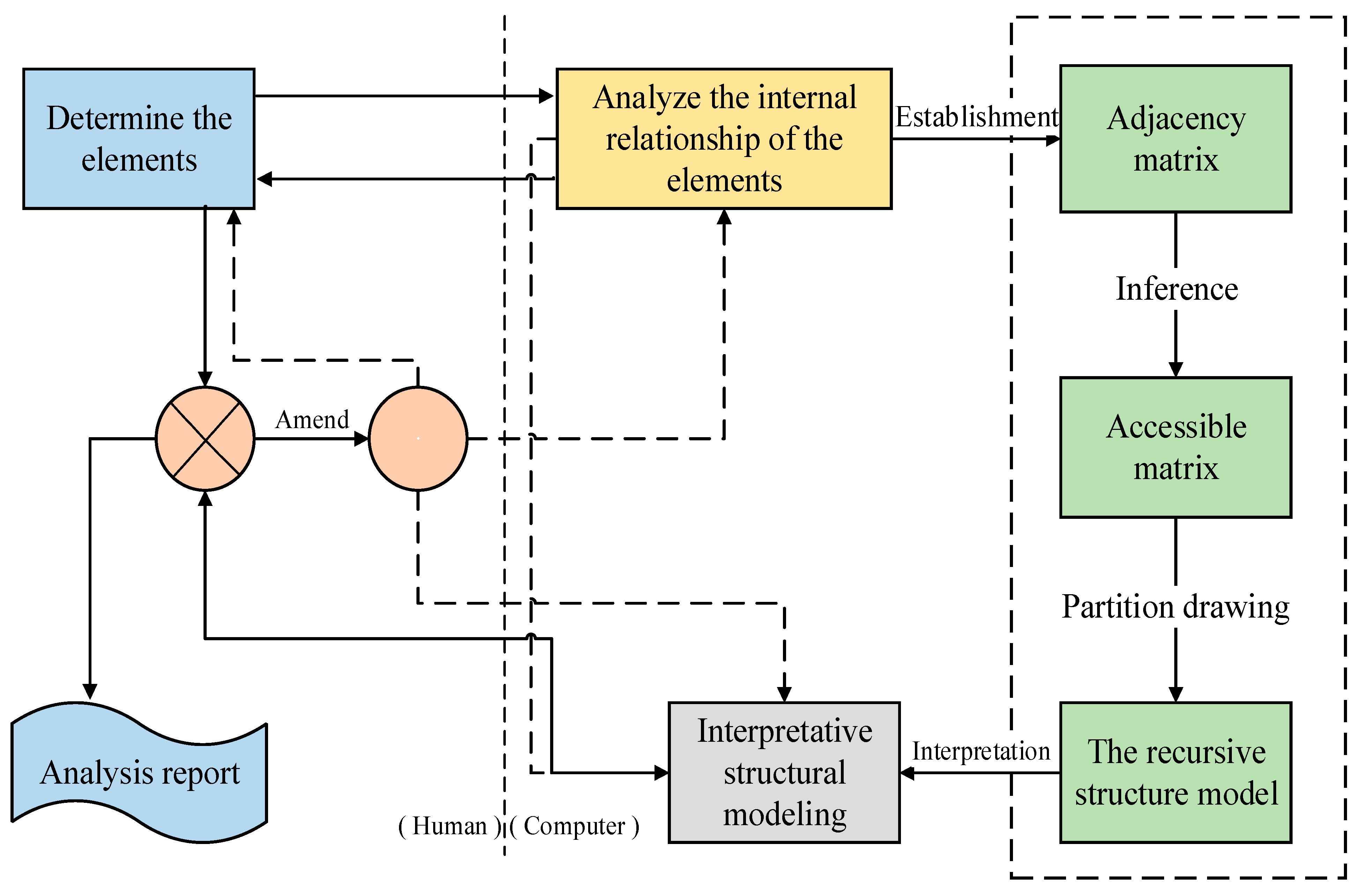
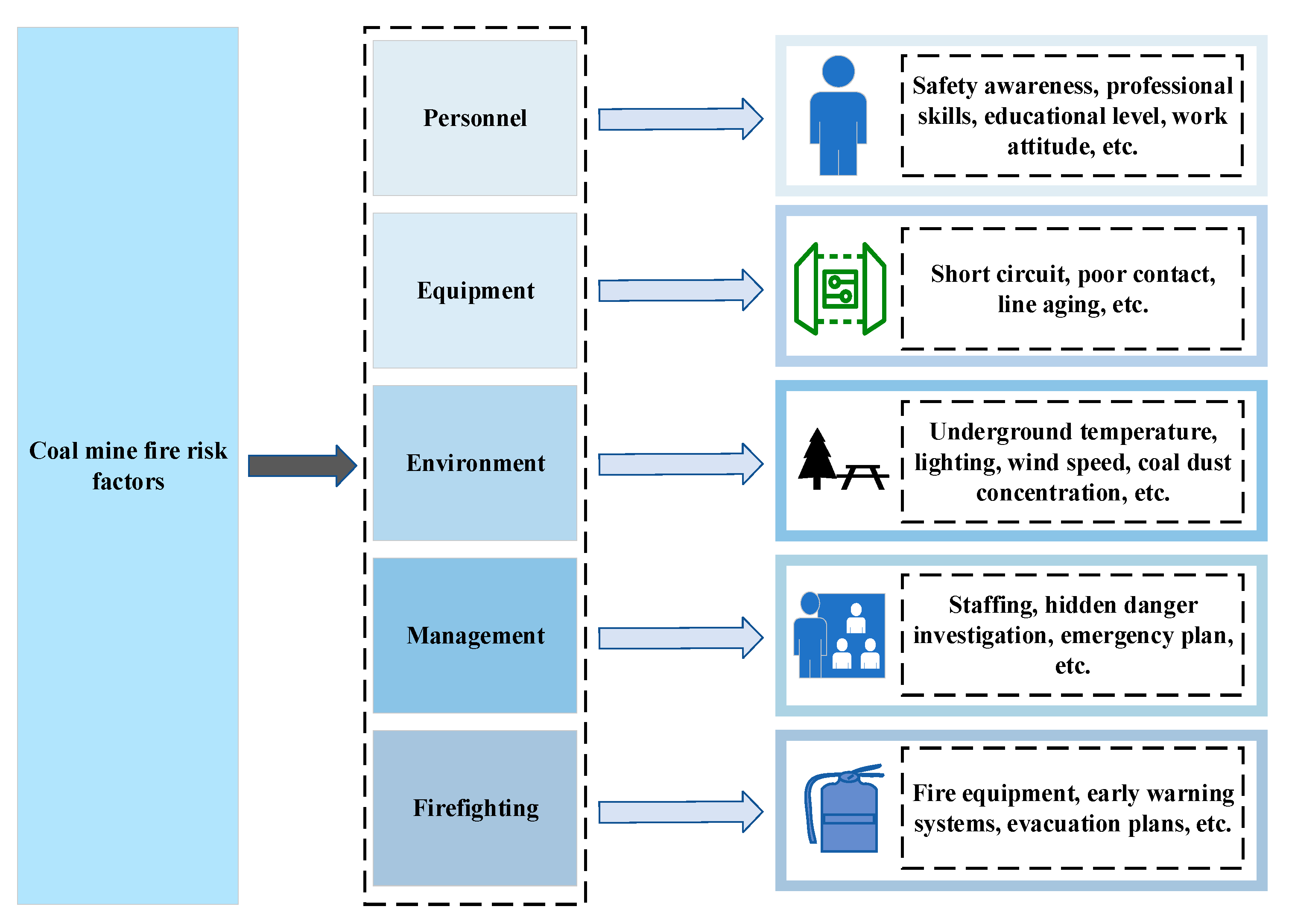
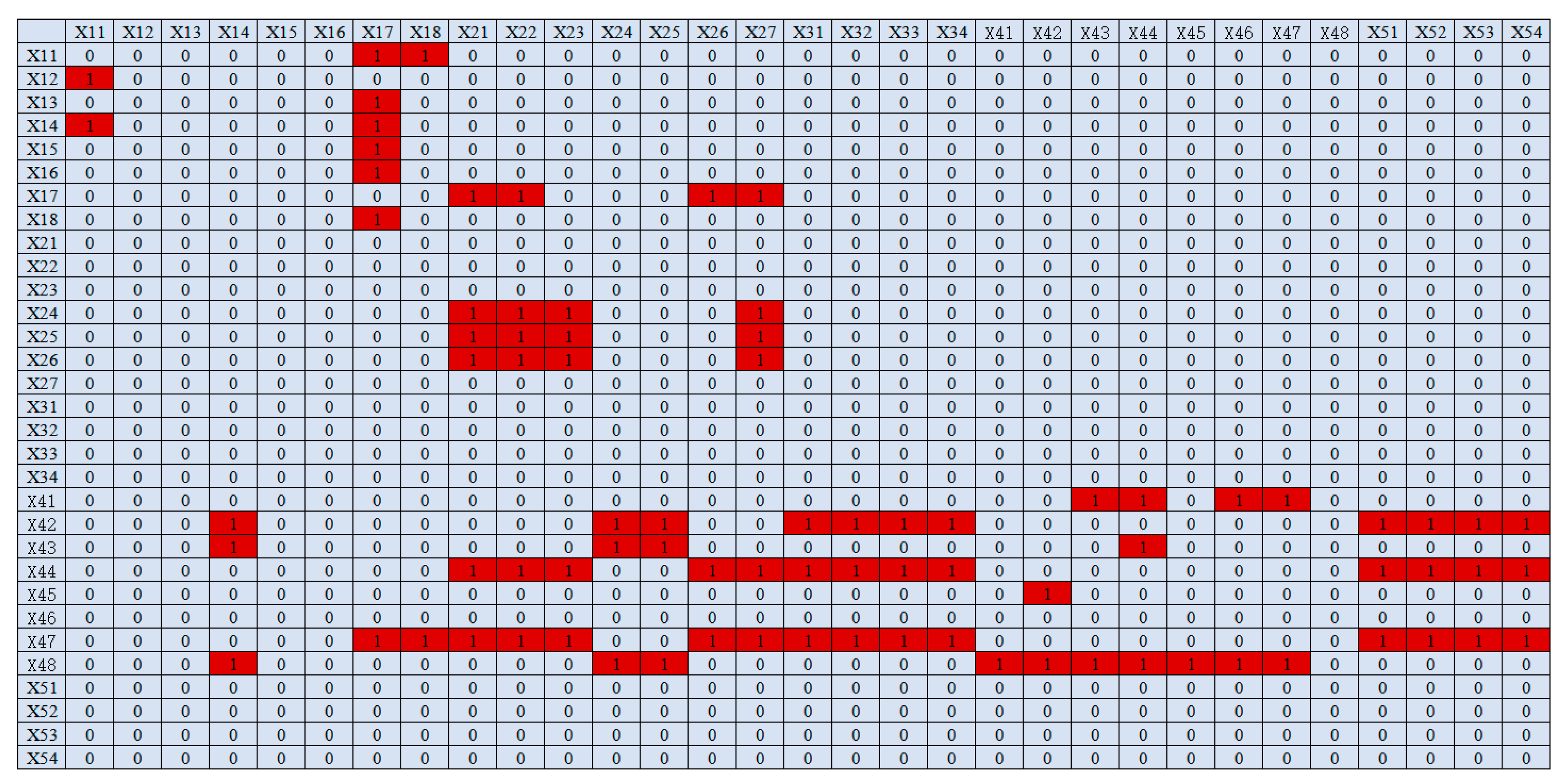
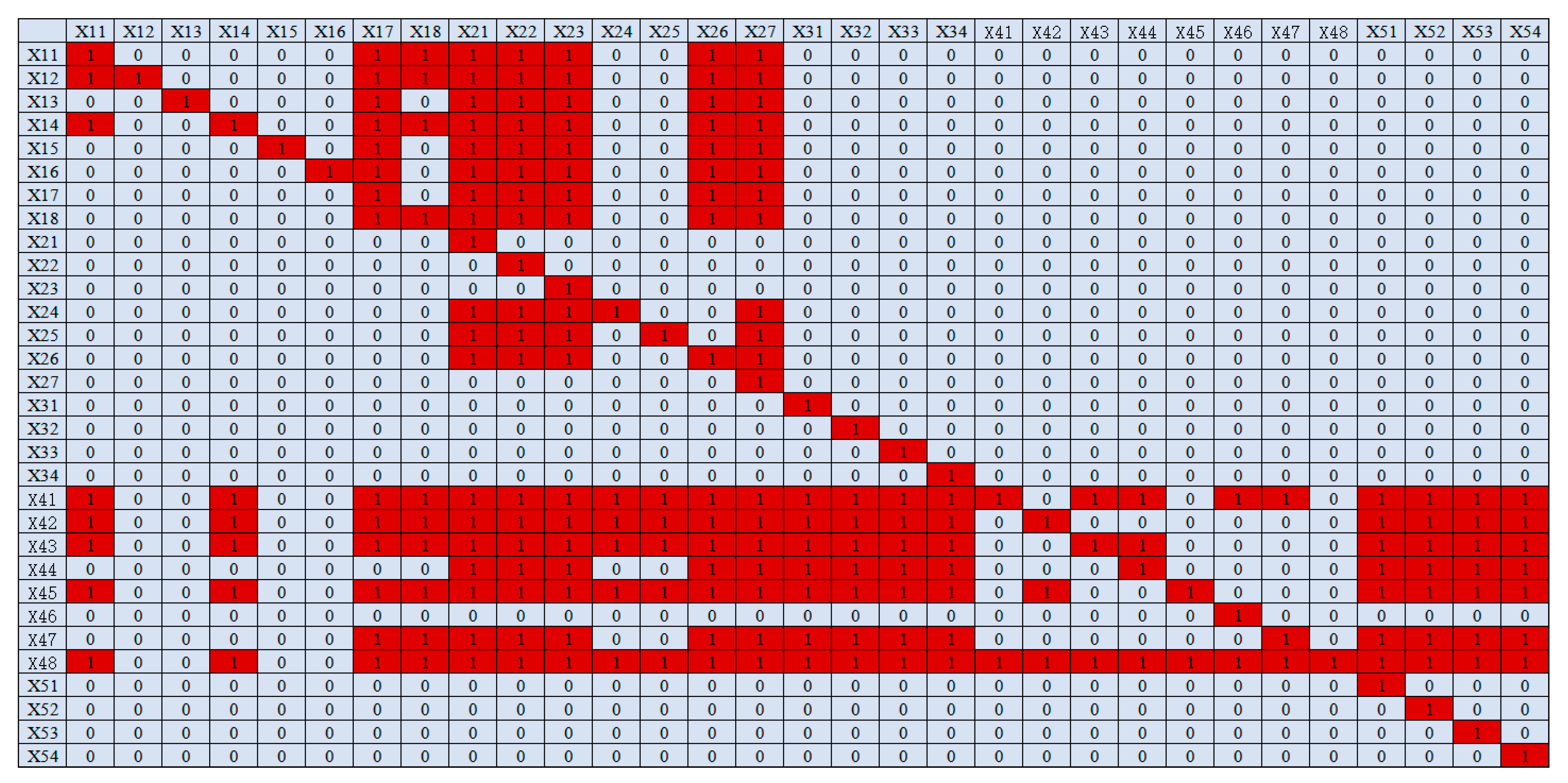




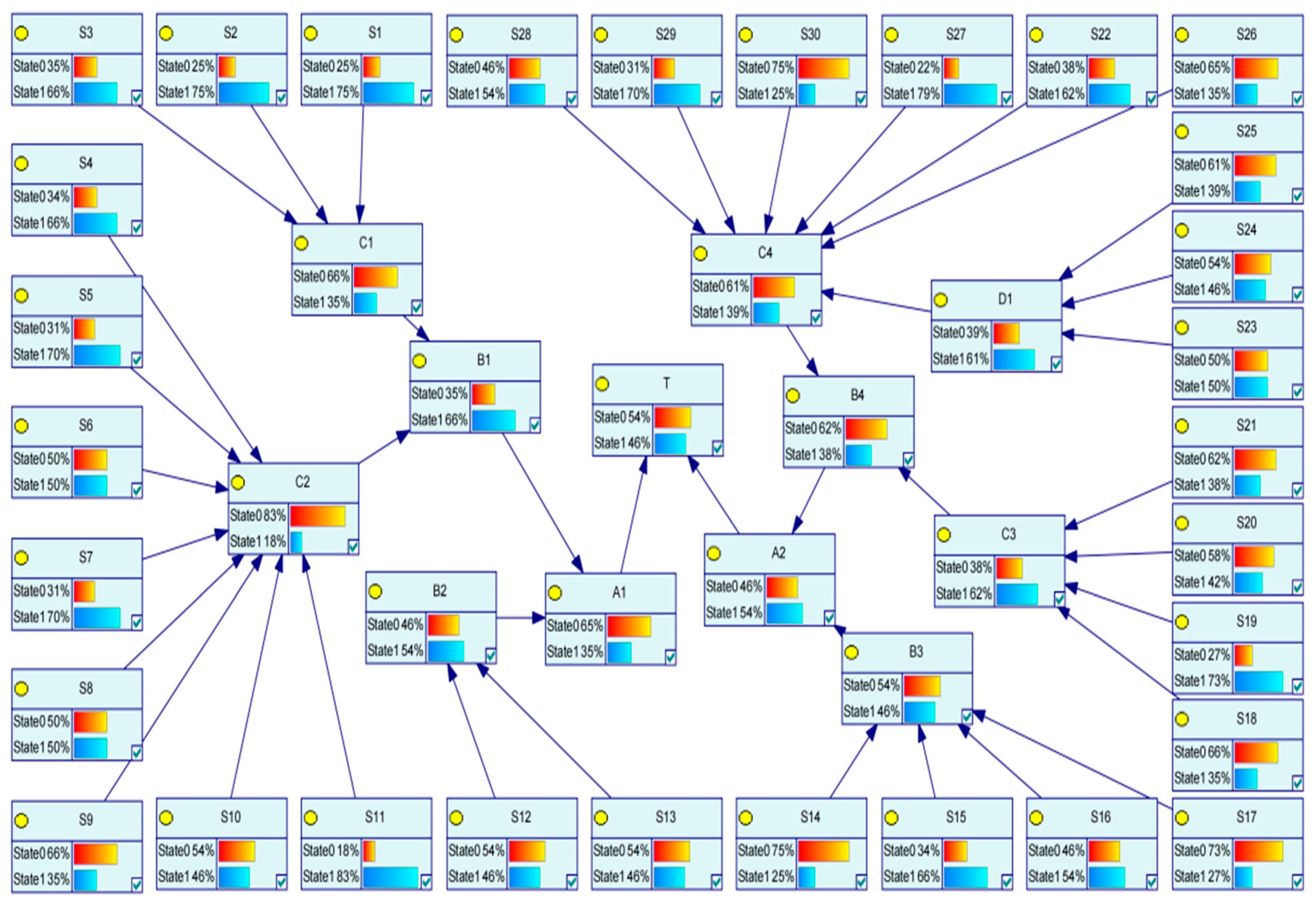


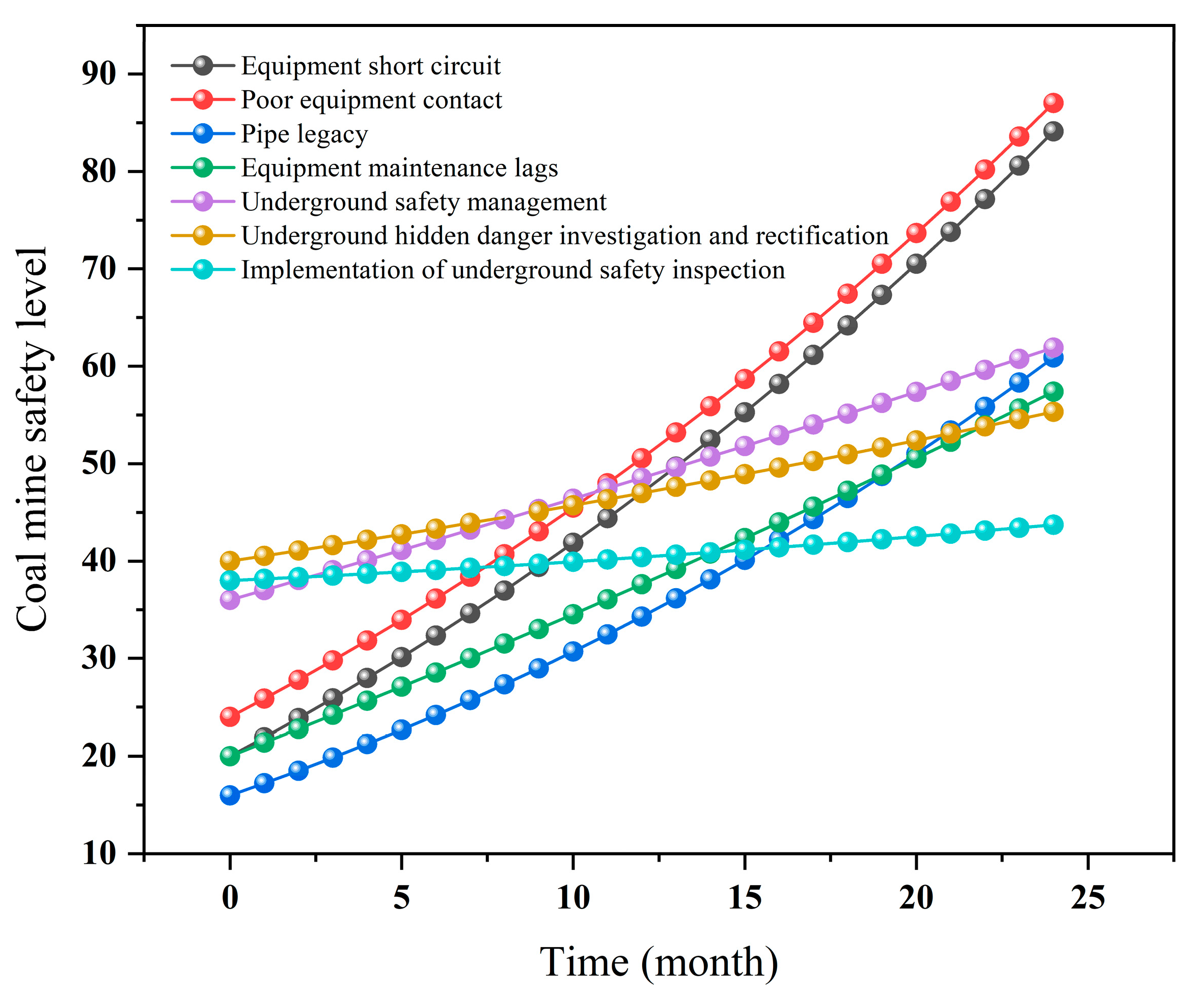
| Level 1 Indicator Xi | Secondary Index Xij | Level 1 Indicator Xi | Secondary Index Xij |
|---|---|---|---|
| Risk factors for personnel X1 | Miners’ safety awareness X11 | Environmental risk factor X3 | Downhole temperature X31 |
| Literacy of miners X12 | Underground coal dust concentration X32 | ||
| Miner’s Professional Skills X13 | Underground lighting X33 | ||
| Miners’ safety education and training X14 | Underground wind speed X34 | ||
| Physical condition of miners X15 | Managing risk factor X4 | Mine Safety Management System X41 | |
| Psychological condition of miners X16 | Implementation of underground safety management X42 | ||
| Operational skills for miners X17 | Insufficient funding for mine safety X43 | ||
| Miner’s work ethic X18 | Underground hidden danger investigation and rectification X44 | ||
| Risk factor for equipment X2 | Short Circuit X21 | Underground technical management staffing X45 | |
| Poor contact X22 | Mine Emergency Response Plan X46 | ||
| Pipeline Aging X23 | Underground safety inspections implemented X47 | ||
| Untimely maintenanceX24 | The main system of responsibility for mine safety X48 | ||
| Untimely replacement X25 | Fire risk factor X5 | Underground fire-Fighting equipment X51 | |
| Improperly installed X26 | Underground fire water supply system X52 | ||
| Component friction X27 | Underground fire monitoring and early warning system X53 | ||
| Equipment overload X28 | Underground personnel evacuation facilities X54 | ||
| Equipment Vibration X29 |
| The Reachable Set R | The Prior Set Q | A = R ∩ Q | |
|---|---|---|---|
| X11 | 1, 7, 8, 9, 10, 11, 14, 15 | 1, 2, 4, 20, 21, 22, 24, 27 | 1 |
| X12 | 1, 2, 7, 8, 9, 10, 11, 14, 15 | 2 | 2 |
| X13 | 3, 7, 9, 10, 11, 14, 15 | 3 | 3 |
| X14 | 1, 4, 7, 8, 9, 10, 11, 14, 15 | 4, 20, 21, 22, 24, 27 | 4 |
| X15 | 5, 7, 9, 10, 11, 14, 15 | 5 | 5 |
| X16 | 6, 7, 9, 10, 11, 14, 15 | 6 | 6 |
| X17 | 7, 9, 10, 11, 14, 15 | 1, 2, 3, 4, 5, 6, 7, 8, 20, 21, 22, 24, 26, 27 | 7 |
| X18 | 7, 8, 9, 10, 11, 14, 15 | 1, 2, 4, 8, 20, 21, 22, 24, 26, 27 | 8 |
| X21 | 9 | 1, 2, 3, 4, 5, 6, 7, 8, 9, 12, 13, 14, 20, 21, 22, 23, 24, 26, 27 | 9 |
| X22 | 10 | 1, 2, 3, 4, 5, 6, 7, 8, 10, 12, 13, 14, 20, 21, 22, 23, 24, 26, 27 | 10 |
| X23 | 11 | 1, 2, 3, 4, 5, 6, 7, 8, 11, 12, 13, 14, 20, 21, 22, 23, 24, 26, 27 | 11 |
| X24 | 9, 10, 11, 12, 15 | 12, 20, 21, 22, 24, 27 | 12 |
| X25 | 9, 10, 11, 13, 15 | 13, 20, 21, 22, 24, 27 | 13 |
| X26 | 9, 10, 11, 14, 15 | 1, 2, 3, 4, 5, 6, 7, 8, 14, 20, 21, 22, 23, 24, 26, 27 | 14 |
| X27 | 15 | 1, 2, 3, 4, 5, 6, 7, 8, 12, 13, 14, 15, 20, 21, 22, 23, 24, 26, 27 | 15 |
| X31 | 16 | 16, 20, 21, 22, 23, 24, 26, 27 | 16 |
| X32 | 17 | 17, 20, 21, 22, 23, 24, 26, 27 | 17 |
| X33 | 18 | 18, 20, 21, 22, 23, 24, 26, 27 | 18 |
| X34 | 19 | 19, 20, 21, 22, 23, 24, 26, 27 | 19 |
| X41 | 1, 4, 7, 8, 9, 10, 11, 12, 13, 14, 15, 16, 17, 18, 19, 20, 22, 23, 25, 26, 28, 29, 30, 31 | 20, 27 | 20 |
| X42 | 1, 4, 7, 8, 9, 10, 11, 12, 13, 14, 15, 16, 17, 18, 19, 21, 28, 29, 30, 31 | 21, 24, 27 | 21 |
| X43 | 1, 4, 7, 8, 9, 10, 11, 12, 13, 14, 15, 16, 17, 18, 19, 22, 23, 28, 29, 30, 31 | 20, 22, 27 | 22 |
| X44 | 9, 10, 11, 14, 15, 16, 17, 18, 19, 23, 28, 29, 30, 31 | 20, 22, 23, 27 | 23 |
| X45 | 1, 4, 7, 8, 9, 10, 11, 12, 13, 14, 15, 16, 17, 18, 19, 21, 24, 28, 29, 30, 31 | 24, 27 | 24 |
| X46 | 25 | 20, 25, 27 | 25 |
| X47 | 7, 8, 9, 10, 11, 14, 15, 16, 17, 18, 19, 26, 28, 29, 30, 31 | 20, 26, 27 | 26 |
| X48 | 1, 4, 7, 8, 9, 10, 11, 12, 13, 14, 15, 16, 17, 18, 19, 20, 21, 22, 23, 24, 25, 26, 27, 28, 29, 30, 31 | 27 | 27 |
| X51 | 28 | 20, 21, 22, 23, 24, 26, 27, 28 | 28 |
| X52 | 29 | 20, 21, 22, 23, 24, 26, 27, 29 | 29 |
| X53 | 30 | 20, 21, 22, 23, 24, 26, 27, 30 | 30 |
| X54 | 31 | 20, 21, 22, 23, 24, 26, 27, 31 | 31 |
| Level | Key Constituent |
|---|---|
| Level 1 (Top floor) | Short circuit X21, Poor contact X22, Pipeline aging X23, Component friction X27, Underground temperature X-1, Underground coal dust concentration X32, Underground lighting X33, Underground wind speed X34, Mine emergency plan X46, Underground fire Fighting equipment X51, Underground fire water supply system X52, Underground fire monitoring and warning system X53, Underground personnel evacuation facilities X54 |
| Layer 2 | Untimely maintenance X24, Untimely replacement X25, Improper installation X26 |
| Layer 3 | Operational Skills for Miners X1–7, Underground Hazard Identification and Rectification X44 |
| Layer 4 | Miners’ professional skills X13, Miners’ physiological condition X15, Miners’ psychological condition X16, Miners’ work attitude X18 |
| Layer 5 | Miners’ safety awareness X11, Underground safety inspection implementation X47 |
| Layer 6 | Miners’ literacy X12, Miners’ safety education and training X14 |
| Layer 7 | Implementation of underground safety management X42, Insufficient investment in mine safety funds X43 |
| Layer 8 | Mine Safety Management System X41, Mine Technical Management Staffing X45 |
| Level 9 (Ground floor) | The main system of responsibility for mine safety X48 |
| one-factor coupling | ordinal number | 10000 = 0 | 01000 = 4 | 00100 = 0 | 00010 = 2 | 00001 = 7 |
| frequency | P00000 = 0 | P01000 = 0.111 | P00100 = 0 | P00010 = 0.037 | P00001 = 0.219 | |
| two-factor coupling (physics) | ordinal number | 11000 = 0 | 10010 = 5 | 10001 = 2 | 01100 = 0 | 01010 = 7 |
| frequency | P11000 = 0 | P10010 = 0.156 | P10001 = 0.063 | P01100 = 0 | P01010 = 0.219 | |
| ordinal number | 01001 = 1 | 00101 = 0 | 00011 = 2 | |||
| frequency | P01001 = 0.031 | P00101 = 0 | P00011 = 0.063 | |||
| multifactor coupling (physics) | ordinal number | 11100 = 0 | 11001 = 0 | 10110 = 2 | 10101 = 0 | 10011 = 1 |
| frequency | P11100 = 0 | P11001 = 0 | P10110 = 0.063 | P10101 = 0 | P10011 = 0.031 | |
| ordinal number | 01110 = 0 | 01011 = 0 | 00111 = 0 | 11110 = 0 | 11101 = 0 | |
| frequency | P01110 = 0 | P01011 = 0 | P00111 = 0 | P11110 = 0 | P11101 = 0 | |
| ordinal number | 11011 = 0 | 01111 = 0 | 11111 = 0 | |||
| frequency | P11011 = 0 | P01111 = 0 | P11111 = 0 | |||
| Type of Coupling | P0---- | P1---- | P-0--- | P-1--- | P--0-- | P--1-- | P---0- | P---1- | P----0 | P----1 |
|---|---|---|---|---|---|---|---|---|---|---|
| probability of occurrence | 0.68 | 0.32 | 0.656 | 0.344 | 0.9686 | 0.0314 | 0.4375 | 0.5625 | 0.625 | 0.375 |
| Type of Coupling | P00--- | P01--- | P10--- | P11--- | P0-0-- | P0-1-- | P1-0-- | P1-1- | P0--0- | P0--1- |
|---|---|---|---|---|---|---|---|---|---|---|
| probability of occurrence | 0.34375 | 0.375 | 0.3125 | 0 | 0.71875 | 0 | 0.25 | 0.0625 | 0.375 | 0.34375 |
| Type of Coupling | P--10- | P--11- | P--0-0 | P--0-1 | P--1-0 | P--1-1 | P---00 | P---01 | P---10 | P---11 |
| probability of occurrence | 0 | 0.0625 | 0.5625 | 0.40625 | 0.0625 | 0 | 0.125 | 0.3125 | 0.5 | 0.09375 |
| Type of Coupling | P000-- | P100-- | P010-- | P001-- | P110-- | P101-- | P011-- | P111-- | P00-0- | P10-0- |
|---|---|---|---|---|---|---|---|---|---|---|
| probability of occurrence | 0.34375 | 0.25 | 0.375 | 0 | 0 | 0.0625 | 0 | 0 | 0.21875 | 0.0625 |
| Type of Coupling | P-1010 | P-1001 | P-0110 | P-0101 | P-0011 | P-1110 | P-1101 | P-1011 | P-0111 | P-1111 |
| probability of occurrence | 0.21875 | 0.03125 | 0.0625 | 0 | 0.09375 | 0 | 0 | 0 | 0 | 0 |
| Two-factor different coupling type T-values | T21(a,b) = 0.037770947 | T22(a,c) = 0.084929436 | T23(a,d) = 0.041260309 |
| T24(a,e) = 0.031281699 | T25(b,c) = 0.062988373 | T26(b,d) = 0.00469738 | |
| T27(b,e) = 0.023699328 | T28(c,d) = 0.073204562 | T29(c,e) = 0.02976152 | |
| T2X(d,e) = 0.01327437 | / | ||
| Three-factor different coupling type T-value | T31(a,b,c) = 0.057001994 | T32(a,b,d) = 0.096712889 | T33(a,b,e) = 0.072712219 |
| T34(a,c,d) = 0.116738007 | T35(a,c,e) = 0.06364763 | T36(a,d,e) = 0.04604338 | |
| T37(b,c,d) = 0.120571186 | T38(b,c,e) = 0.082375315 | T39(b,d,e) = 0.107674675 | |
| T3X(c,d,e) = 0.15010004 | / | ||
| T-values for different coupling types for the four factors | T41(a,b,c,d) = 0.154400718 | T42(a,b,c,e) = 0.228547133 | T43(a,b,d,e) = 0.137195422 |
| T44(a,c,d,e) = 0.308599879 | T45(b,c,d,e) = 0.342646012 | ||
| Five-factor coupling T-value | T5(a,b,c,d,e) = 0.27943722 | / | |
| Preliminary Classification Categories | Secondary Classification Categories | Factors Affecting Fire Accidents in Coal Mines |
|---|---|---|
| managerial | People management | Inadequate fire emergency escape training (S1) Unreasonable control of the number of personnel in the area of operation (S2) Inadequate implementation of individual protective measures (S3) Unclear security responsibilities (S4) |
| Institutionalization | Failure to study and optimize fire contingency plans (S5) Failure to define fire Fighting processes and procedures (S6) Inadequate fire Fighting equipment and facilities (S7) Inadequate fire prevention technical measures (S8) | |
| matrix | tectonics | Fire susceptibility due to anomalous geological structure of coal seams (S9) Hot and dry climate increases fire risk (S10) |
| coal bed condition | Excessive accumulation of coal dust (S11) Inadequate support due to reduced coal pillar (S12) Fires caused by cracks and holes in coal seams (S13) | |
| installations | operating equipment | Use of flammable lubricants and materials (S14) Sparks or high temperatures from operating equipment (S15) |
| safety equipment | Inadequate fire monitoring systems (S16) Failure of automatic fire extinguishing equipment (S17) Improper storage of fire extinguishing equipment (S18) Inadequate security facilities (S19) Electrical equipment not complying with explosion-proof standards (S20) | |
| technology | work process | Improper operation of hot work (S21) Fires caused by coal seam mining (S22) Fire caused by careless welding and cutting operations (S23) Roof collapse leading to ignition source (S24) |
| Ventilation process | Unreasonable ventilation(S25) Fire caused by faulty ventilation equipment (S26) | |
| officers | worker | Laxity in fire prevention due to luck (S27) Operators lack the necessary fire emergency knowledge and skills (S28) |
| managerial staff | Failure to have specialized technical staff dedicated to fire monitoring and early warning (S29) Lack of management attention to fire prevention (S30) | |
| Upper index code | Coal mine fire accident occurred (T) Coal seam fire (A1) Lack of protective measures (A2) Coal seam fire diffusion (B1) Insufficient ventilation capacity (B2) Abnormal automatic fire extinguishing system (B3) human risks (B4) Coal seam fire source (C1) Factor concentration (C2) Weak safety awareness (C3) Inadequate management mechanism (C4) The emergency plan is not perfect (D1) | |
| Evidence Node | Expert 1 | Expert 2 | Expert 3 | Expert 4 | Expert 5 |
|---|---|---|---|---|---|
| S1 | (0.9,1.0,1.0) | (0.5,0.7,0.9) | (0.7,0.9,1.0) | (0.5,0.7,0.9) | (0.3,0.5,0.7) |
| S2 | (0.3,0.5,0.7) | (0.5,0.7,0.9) | (0.9,1.0,1.0) | (0.5,0.7,0.9) | (0.7,0.9,1.0) |
| S3 | (0.3,0.5,0.7) | (0.3,0.5,0.7) | (0.5,0.7,0.9) | (0.5,0.7,0.9) | (0.7,0.9,1.0) |
| S4 | (0.3,0.5,0.7) | (0.5,0.7,0.9) | (0.7,0.9,1.0) | (0.5,0.7,0.9) | (0.3,0.5,0.7) |
| S5 | (0.5,0.7,0.9) | (0.7,0.9,1.0) | (0.3,0.5,0.7) | (0.5,0.7,0.9) | (0.5,0.7,0.9) |
| S6 | (0.1,0.3,0.5) | (0.3,0.5,0.7) | (0.3,0.5,0.7) | (0.5,0.7,0.9) | (0.3,0.5,0.7) |
| S8 | (0.3,0.5,0.7) | (0.5,0.7,0.9) | (0.3,0.5,0.7) | (0.3,0.5,0.7) | (0.1,0.3,0.5) |
| S9 | (0.1,0.3,0.5) | (0.3,0.5,0.7) | (0.1,0.3,0.5) | (0.0,0.1,0.3) | (0.3,0.5,0.7) |
| S10 | (0.1,0.3,0.5) | (0.3,0.5,0.7) | (0.5,0.7,0.9) | (0.3,0.5,0.7) | (0.1,0.3,0.5) |
| S11 | (0.7,0.9,1.0) | (0.5,0.7,0.9) | (0.5,0.7,0.9) | (0.7,0.9,1.0) | (0.9,1.0,1.0) |
| S12 | (0.3,0.5,0.7) | (0.1,0.3,0.5) | (0.3,0.5,0.7) | (0.5,0.7,0.9) | (0.1,0.3,0.5) |
| S13 | (0.1,0.3,0.5) | (0.3,0.5,0.7) | (0.5,0.7,0.9) | (0.3,0.5,0.7) | (0.1,0.3,0.5) |
| S14 | (0.1,0.3,0.5) | (0.0,0.1,0.3) | (0.3,0.5,0.7) | (0.1,0.3,0.5) | (0.0,0.0,0.1) |
| S15 | (0.5,0.7,0.9) | (0.3,0.5,0.7) | (0.5,0.7,0.9) | (0.3,0.5,0.7) | (0.7,0.9,1.0) |
| S16 | (0.3,0.5,0.7) | (0.5,0.7,0.9) | (0.5,0.7,0.9) | (0.3,0.5,0.7) | (0.1,0.3,0.5) |
| S17 | (0.0,0.1,0.3) | (0.1,0.3,0.5) | (0.3,0.5,0.7) | (0.0,0.1,0.3) | (0.1,0.3,0.5) |
| S18 | (0.1,0.3,0.5) | (0.3,0.5,0.7) | (0.0,0.1,0.3) | (0.3,0.5,0.7) | (0.1,0.3,0.5) |
| S19 | (0.5,0.7,0.9) | (0.7,0.9,1.0) | (0.3,0.5,0.7) | (0.7,0.9,1.0) | (0.5,0.7,0.9) |
| S20 | (0.1,0.3,0.5) | (0.3,0.5,0.7) | (0.1,0.3,0.5) | (0.3,0.5,0.7) | (0.3,0.5,0.7) |
| S21 | (0.1,0.3,0.5) | (0.3,0.5,0.7) | (0.1,0.3,0.5) | (0.1,0.3,0.5) | (0.3,0.5,0.7) |
| S22 | (0.5,0.7,0.9) | (0.3,0.5,0.7) | (0.5,0.7,0.9) | (0.5,0.7,0.9) | (0.3,0.5,0.7) |
| S23 | (0.5,0.7,0.9) | (0.3,0.5,0.7) | (0.3,0.5,0.7) | (0.3,0.5,0.7) | (0.1,0.3,0.5) |
| S24 | (0.3,0.5,0.7) | (0.1,0.3,0.5) | (0.5,0.7,0.9) | (0.3,0.5,0.7) | (0.1,0.3,0.5) |
| S25 | (0.5,0.7,0.9) | (0.1,0.3,0.5) | (0.1,0.3,0.5) | (0.3,0.5,0.7) | (0.0,0.1,0.3) |
| S26 | (0.1,0.3,0.5) | (0.3,0.5,0.7) | (0.0,0.1,0.3) | (0.3,0.5,0.7) | (0.1,0.3,0.5) |
| S27 | (0.9,1.0,1.0) | (0.7,0.9,1.0) | (0.5,0.7,0.9) | (0.3,0.5,0.7) | (0.7,0.9,1.0) |
| S28 | (0.5,0.7,0.9) | (0.3,0.5,0.7) | (0.3,0.5,0.7) | (0.3,0.5,0.7) | (0.3,0.5,0.7) |
| S29 | (0.5,0.7,0.9) | (0.3,0.5,0.7) | (0.5,0.7,0.9) | (0.7,0.9,1.0) | (0.5,0.7,0.9) |
| S30 | (0.0,0.0,0.1) | (0.1,0.3,0.5) | (0.3,0.5,0.7) | (0.1,0.3,0.5) | (0.0,0.1,0.3) |
| Evidence Node | Homogenization Results | State1 | State0 |
|---|---|---|---|
| S1 | (0.58,0.76,0.9) | 0.75 | 0.25 |
| S2 | (0.58,0.76,0.9) | 0.75 | 0.25 |
| S3 | (0.46,0.66,0.84) | 0.655 | 0.345 |
| S4 | (0.46,0.66,0.84) | 0.655 | 0.345 |
| S5 | (0.5,0.7,0.88) | 0.695 | 0.305 |
| S6 | (0.3,0.5,0.7) | 0.5 | 0.5 |
| S7 | (0.5,0.7,0.88) | 0.695 | 0.305 |
| S8 | (0.3,0.5,0.7) | 0.5 | 0.5 |
| S9 | (0.16,0.34,0.54) | 0.345 | 0.655 |
| S10 | (0.26,0.46,0.66) | 0.46 | 0.54 |
| S11 | (0.66,0.84,0.96) | 0.825 | 0.175 |
| S12 | (0.26,0.46,0.66) | 0.46 | 0.54 |
| S13 | (0.26,0.46,0.66) | 0.46 | 0.54 |
| S14 | (0.1,0.24,0.42) | 0.25 | 0.75 |
| S15 | (0.46,0.66,0.84) | 0.655 | 0.345 |
| S16 | (0.34,0.54,0.74) | 0.54 | 0.46 |
| S17 | (0.1,0.26,0.46) | 0.27 | 0.73 |
| S18 | (0.16,0.34,0.54) | 0.345 | 0.655 |
| S19 | (0.54,0.74,0.9) | 0.73 | 0.27 |
| S20 | (0.22,0.42,0.62) | 0.42 | 0.58 |
| S21 | (0.18,0.38,0.58) | 0.38 | 0.62 |
| S22 | (0.42,0.62,0.82) | 0.62 | 0.38 |
| S23 | (0.3,0.5,0.7) | 0.5 | 0.5 |
| S24 | (0.26,0.46,0.66) | 0.46 | 0.54 |
| S25 | (0.2,0.38,0.58) | 0.385 | 0.615 |
| S26 | (0.16,0.34,0.54) | 0.345 | 0.655 |
| S27 | (0.62,0.8,0.92) | 0.785 | 0.215 |
| S28 | (0.34,0.54,0.74) | 0.54 | 0.46 |
| S29 | (0.5,0.7,0.88) | 0.695 | 0.305 |
| S30 | (0.1,0.24,0.42) | 0.25 | 0.75 |
Disclaimer/Publisher’s Note: The statements, opinions and data contained in all publications are solely those of the individual author(s) and contributor(s) and not of MDPI and/or the editor(s). MDPI and/or the editor(s) disclaim responsibility for any injury to people or property resulting from any ideas, methods, instructions or products referred to in the content. |
© 2025 by the authors. Licensee MDPI, Basel, Switzerland. This article is an open access article distributed under the terms and conditions of the Creative Commons Attribution (CC BY) license (https://creativecommons.org/licenses/by/4.0/).
Share and Cite
Tan, S.; Shi, J.; Zhang, Z.; Qian, Z. Dynamic and Multidimensional Risk Assessment Methodology for Coal Mine Fire Prevention: An INK-FBSD Approach. Fire 2025, 8, 456. https://doi.org/10.3390/fire8120456
Tan S, Shi J, Zhang Z, Qian Z. Dynamic and Multidimensional Risk Assessment Methodology for Coal Mine Fire Prevention: An INK-FBSD Approach. Fire. 2025; 8(12):456. https://doi.org/10.3390/fire8120456
Chicago/Turabian StyleTan, Shuwen, Junwei Shi, Ziyan Zhang, and Zhean Qian. 2025. "Dynamic and Multidimensional Risk Assessment Methodology for Coal Mine Fire Prevention: An INK-FBSD Approach" Fire 8, no. 12: 456. https://doi.org/10.3390/fire8120456
APA StyleTan, S., Shi, J., Zhang, Z., & Qian, Z. (2025). Dynamic and Multidimensional Risk Assessment Methodology for Coal Mine Fire Prevention: An INK-FBSD Approach. Fire, 8(12), 456. https://doi.org/10.3390/fire8120456






